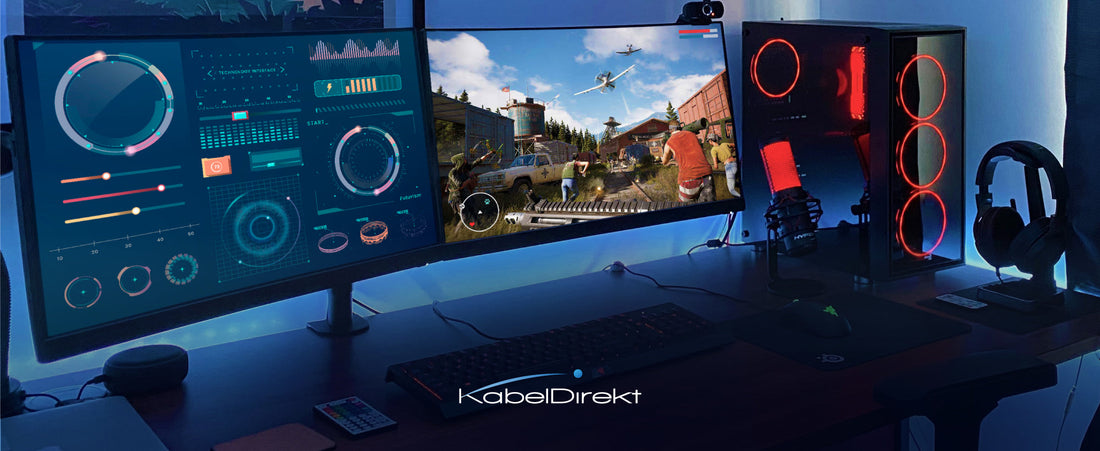
DISPLAYPORT 2.1, 2.1a AND 2.0 - WHAT YOU NEED TO KNOW
Share

The DisplayPort standard is continuously evolving, offering higher bandwidth, better image quality, and more flexibility with its latest versions: 2.0, 2.1, and 2.1a. These improvements benefit gamers, content creators, and professional users.
But what exactly differentiates these versions, what advantages do they bring, and what does this mean for the future of video transmission? In this article, we take a detailed look at the most important updates and answer frequently asked questions.
The Evolution of DisplayPort: An Overview
Since its introduction in 2006, the DisplayPort standard has established itself as a powerful alternative to HDMI. In the PC sector, as well as for high-end displays and VR technologies, DisplayPort offers advantages in image quality and refresh rates. However, televisions typically do not feature a DisplayPort connection. The latest versions continue this trend and bring significant technical improvements.
DisplayPort 2.0: A Major Leap Forward
- Released: June 2019
- Maximum Data Rate: Up to 80 Gbit/s
- Resolution & Refresh Rate: Up to 16K at 60 Hz or multiple 4K displays with high refresh rates
DisplayPort 2.0 marked a significant advancement over previous versions. Its key features include:
- Increased Bandwidth: By switching to a more efficient encoding (128b/132b), the effective data rate was greatly improved.
- Support for Display Stream Compression (DSC) 1.2a: Enables lossless compression, allowing for higher resolutions and refresh rates.
- Better Multi-Monitor Support: Multiple 4K displays can be connected with high refresh rates.
Although DP 2.0 introduced significant performance improvements, it took some time for hardware support, such as graphics cards and monitors, to become available. Meanwhile, further optimizations followed with DisplayPort 2.1.
DisplayPort 2.1: More Efficiency and Better Compatibility
- Released: October 2022
- Maximum Data Rate: Up to 80 Gbit/s
- New Features: Optimized integration with USB4, improved cable certifications
DisplayPort 2.1 primarily introduced optimizations in bandwidth management and compatibility:
- Integration with USB4: The DisplayPort architecture was optimized for shared use with USB4, improving bandwidth management efficiency.
- New Cable Certifications: DP40 and DP80 cables guarantee performance of 40 Gbit/s and 80 Gbit/s, respectively.
- More Efficient Tunneling: DP 2.1 allows for better coexistence of DisplayPort signals with other data streams in USB4 environments.
DisplayPort 2.1a: Improved Cable Length and New Certification
- Released: January 2024
- Maximum Data Rate: 54 Gbit/s over passive cables up to 2 meters long
With DisplayPort 2.1a, the primary improvement was increased usable cable length:
- Longer Passive Cables: DisplayPort 2.1 supports high data rates over more than two meters without requiring an active cable.
- DP54 Cable Standard: New certification for four-lane cables that operate under the UHBR13.5 standard, allowing higher data rates over longer distances.
Frequently Asked Questions About DisplayPort 2.0, 2.1, and 2.1a
Are there adapters from HDMI to DisplayPort and vice versa?
Yes, adapters exist in both directions. Converting from DisplayPort to HDMI is relatively simple because DisplayPort uses a more flexible signal, and many graphics cards can output an HDMI signal through DisplayPort. Converting from HDMI to DisplayPort, however, requires an active converter (usually with its own USB power supply) since HDMI does not natively support a DisplayPort signal.
Which is better, HDMI 2.1 or DisplayPort 2.1?
It depends on the use case:
- HDMI 2.1: More widespread, especially in televisions and gaming consoles.
- DisplayPort 2.1: Offers higher bandwidth, better multi-monitor support, and is mainly used for high-end monitors, graphics cards, and professional workstations.
Is DisplayPort 2.1 backward compatible?
Yes, DisplayPort 2.1 is fully backward compatible with previous DisplayPort versions. This means DP 2.1 devices also work with DP 1.4 and DP 1.2 hardware, but only within the lower bandwidth and feature limitations of the older standards.
What is the difference between DisplayPort 2.0, 2.1, and 2.1a?
- DP 2.0: Introduced a significant bandwidth increase to 80 Gbit/s, enabling extremely high resolutions.
- DP 2.1: Optimized integration with USB4 and introduced new cable certifications.
- DP 2.1a: Improved cable length and support for longer passive cables.
Conclusion
The latest DisplayPort versions offer significant improvements in bandwidth, compatibility, and flexibility. While DisplayPort 2.0 laid the foundation for ultra-high-resolution displays, DP 2.1 improved integration with modern interfaces like USB4. DP 2.1a brings further optimizations, especially for longer cables.
Although HDMI continues to dominate the TV and gaming market, DisplayPort remains essential for professional applications, gaming monitors, and VR technologies. Anyone looking to invest in the future of video transmission should keep an eye on the latest DisplayPort versions.
